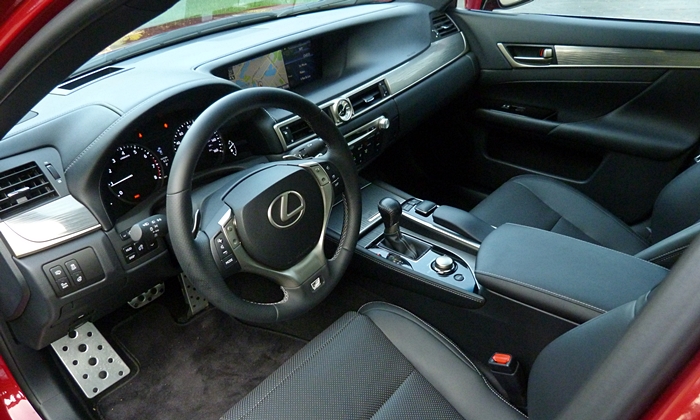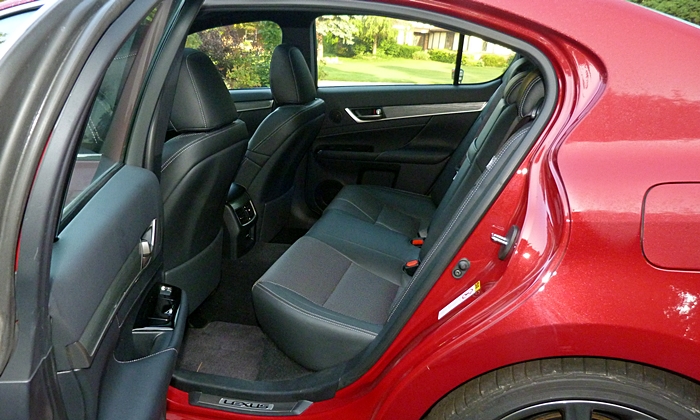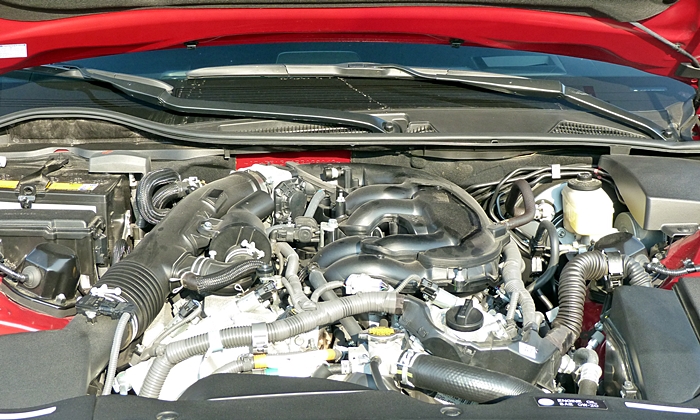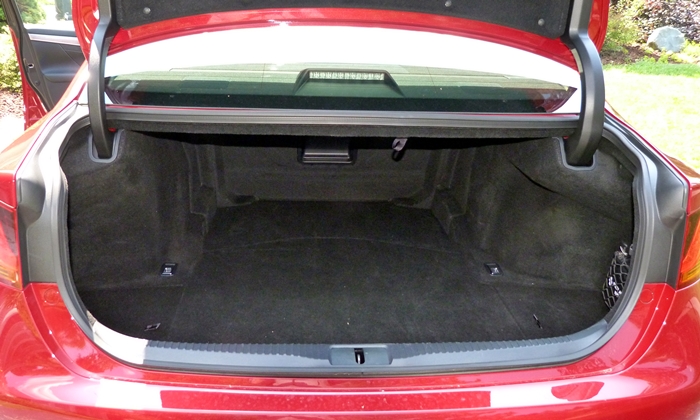A couple years ago I evaluated the then-new Lexus GS 350 F Sport, and found a lot to like. But both tested 2013s I had all-wheel drive (AWD). Lexus fits additional performance-oriented hardware to the rear-wheel drive (RWD) GS F Sport, active front-wheel steering and (for another $1,700) rear-wheel steering. These additions should make it even more entertaining. Perhaps a rear-drive F Sport was available for testing this year? One was.
And the comparison car? In the interim Cadillac had redesigned the CTS, making it arguably the best-driving car in the segment. But the Cadillac doesn't offer active front wheel steering or rear-wheel steering. Does the GS F Sport's additional tech give it an advantage?

A BMW with a Japanese face. more GS photos

Interesting interior styling. Some elements work better than others.
| |
Compared to the CTS |
| Depreciation |
 Better
Worse
Better
Worse
|
Among the primary reasons, if not the primary reason, people buy a Lexus instead of another premium car is that they tend to be more reliable, especially as they age. Leasing for a few years? Then get that Audi, BMW, or Cadillac. Planning to buy and hold? Then the Lexus likely will induce fewer headaches down the road.
My father owned a 2000 Lexus GS for eight years, after which I owned the car for three. Even with 115,000 miles on the clock I wasn't worried about its reliability. I would have been with a German car of a similar age. During the three years I had the GS I had to replace a tie-rod end and a brake caliper, neither of which was expensive.
In TrueDelta's car reliability survey data, though, the 2013 Lexus GS has a spotty record. This could be because our sample size is small; elsewhere the car has top reliability scores. Still, I'm not comfortable placing reliability among the best reasons to buy the current GS.
I am, however, comfortable putting a related category in the top spot. A car's resale value reflects how reliable used car buyers expect it will be. People expect (usually with justification) that a Lexus will remain reliable as it ages, so the resale values of its cars tend to be strong. According to kbb.com, a well-equipped 2009 Cadillac CTS with 60,000 miles can be sold for about $16,000 (at the time I'm writing this). A Lexus GS 350 of the same age? About $21,000.
| Price or payments |
 Better
Worse
Better
Worse
|
You'll be able to sell the Lexus for more, yet it will cost less to buy, at least if the window stickers are any indication. A 2015 GS 350 with the F Sport Package, no-cost nav, and head-up display lists for $55,250, over $7,000 less than a similarly eqipped CTS. The CTS does include additional features worth about $2,700, but these explain only some of the difference. German competitors tend to cost even more than the Cadillac.
Then again, for an upscale midsize sedan at an even lower price, check out the impressive new, much improved 2015 Hyundai Genesis.

Larger windows than on the Cadillac afford good outward visibility.

Sport mode knob close at hand. Mouse-like controller for infotainment display.
| Front seat support & comfort |
 Better
Worse
Better
Worse
|
The best thing about driving the Lexus GS F Sport two years ago remains the best thing. Its highly adjustable driver seat ranks among the few that are both supportive during aggressive driving and comfortable all the time. Adjustments include bi-level lumber, side bolsters, and thigh support. (Note: You can get the same adjustments on the passenger side, but only with the Luxury Package, not the F Sport.)
The Cadillac's seats, while far from punishing, aren't as form-fitting or as comfortable. You also sit lower in the CTS, good for feeling sporty, not so good for seeing out of the car. The larger windows in the Lexus also boost driver confidence.
| Exterior styling |
 Better
Worse
Better
Worse
|
Not everyone likes the exterior styling of the latest Lexus GS. The front end, with its "spindle grille" (meant to evoke Toyota's origins as a loom maker) especially has its critics.
Personally, though, I like how the spindle grille works with the F Sport front fascia to lend the latest GS a distinctively Japanese fierceness you won't find elsewhere. (I don't care for the weak-chinned non-F.) This front end does look better in grays and silvers (see the full photo gallery) than in the tested car's red.
Beyond the front end, the GS bears more than a passing resemblance to the BMW 5-Series. It's round, flowing form looks pleasant enough, and even sporty with the F Sport's gray 19-inch wheels, but it's less special than the face.
I'm less a fan of the Cadillac's exterior. Compared to the first- and second-generation iterations of the CTS, the new one has been toned down in search of broader appeal, especially in Asian markets. The new body, which looks a lot like a Mercedes E-Class, bores me. So, unlike most reviewers, I perfer the bolder Lexus.
| |
Compared to the CTS |
| Interior styling |
 Better
Worse
Better
Worse
|
There aren't any strong reasons not to buy a Lexus GS. The best one I can come up with: the instrument panel, designed to include a large central display without a bulge, appears bulky and is oddly half-upholstered.
I do like the F Sport interior's aluminum trim, which has an interesting woodgrain-like texture. And, if you want something more cheerful than the all-black interior of the tested car, brick-colored leather is offered.
The trunk of the Lexus GS, at 14 cubic feet, is about average in size for the segment. But, unlike in the CTS or the Germans, it's not possible to fold the rear seat to expand the trunk. If you require this feature, the GS is out of the running.

I'm usually not a fan of Lexus's spindle grille, but it works with the F Sport fascia.

Rear seat comfortable and fairly roomy. The cushion is position lower in the Cadillac.
| |
Compared to the CTS |
| Powertrain performance |
 Better
Worse
Better
Worse
|
When Lexus introduced a direct-injected 306-horsepower 3.5-liter V6 in the 2006 GS and IS, many people took notice. Audi's, BMW's, and Cadillac's six-cylinder engines were only good for 255 horsepower. On top of its power advantage, the Lexus V6 was smooth and produced thrilling noises when revved.
Fast forward to 2015, and Audi and BMW offer boosted as well as direct-injected sixes with more peak power and far stouter midranges. Cadillac's six remains normally aspirated, but gained direct injection in 2008 and is now good for 321 horsepower. Meanwhile, the Lexus engine has not changed, so it isn't nearly as competitive now as it used to be. In fairly casual driving, if far from sluggish, the GS 350 doesn't feel nearly as strong as the Audi and BMW. Still, your ears might prefer the Lexus. Its engine continues to voice purer, more thrilling noises when revved.
Through 2005 the GS was also offered with a V8 engine. From 2006 on, though, it has only been available with a V6. The performance option has been a modestly quicker but significantly heavier V6 hybrid. For 2016, though, a much stronger V8 will again be offered in a GS-F high-performance variant. So, if you've been wanting a GS, but need more thrust than the current offerings can dish out, wait just one more year.
In its default mode, the eight-speed automatic behaves well, with barely noticeable shifts. In sport mode, though, it can seem indecisive and not so smooth. (Note: The AWD version tested last time continues to pair the V6 with an older, six-speed automatic.)
| Fuel economy |
 Better
Worse
Better
Worse
|
Last time around I listed fuel economy among the reasons not to buy a Lexus GS 350. But the RWD car, with less weight and two more gears in its box, is more efficient on the highway, with an EPA rating up 3 mpg to a competitive 29. (The EPA rating is 19 with either drivetrain.)
In my real-world driving the trip computer reported averages from 19 to 22 in the suburbs and from 26 to 30 on the highway.
Need better fuel economy? Lexus also offers the GS in 450h hybrid form with EPA ratings of 29 city, 34 highway. These figures are better those earned by Audi and BMW diesels in the city, but the tables turn on the highway.
| Handling |
 Better
Worse
Better
Worse
|
I had hoped to report that the GS 350 RWD handles excellently, despite the brand's cushmobile image. Unfortunately, its chassis tuning isn't quite where it needs to be. The GS behaves well when pushed, but never feels quite right, and I couldn't connect with it. Perhaps because of the RWD-only active ratio mechanism, the steering often seems twitchy around a dead spot on-center in normal mode. The system tightens up in sport mode, but it never feels as predictably linear, as precise, or as communicative as the steering in the CTS. On top of this, the GS, like the current 5-Series (if to a lesser extent) feels larger, heavier, and softer than the CTS. Good for luxury, not good for sport.
Perhaps most disappointing: there's no good way to take advantage of the additional dynamic potential of the rear-wheel drive, all-wheels steering configuration. When engaged, the stability control prevents even a hint of oversteer. A sport setting that permitted a modest amount of oversteer would help, but one is not offered. Instead, you must choose between a killjoy stability control system and no safety net at all.
Did the $1,700 all-wheel steering system make a difference? Not that I could tell. Perhaps when driven back-to-back on a track. On public roads I somehow more enjoyed driving the AWD F Sport, which lacked both this option and the RWD's active ratio front steering.
A note on the Lexus GS's sport mode: unlike in Audis and BMWs, it's not possible to separately configure the drivetrain and chassis. If you want the tighter feel of the chassis in sport mode, you'll also have to live with that mode's fuel-wasting drivetrain calibration.
| Ride smoothness |
 Better
Worse
Better
Worse
|
With its semi-sport tuning, the suspension of the GS 350 F Sport falls into a No Man's Land. It's too soft for sporty driving, but can feel jittery when you just want to relax. To the Lexus's credit, there's little of the tire thump you'll experience in a BMW. But the CTS rides a little better and feels more solid.
Noise levels are similarlly good but not great. Those seeking an isolation chamber will be happier in the flagship LS.
The GS 350 F Sport peforms and handles better than most people expect a Lexus to, but not as well as the exceptionally capable Cadillac. The active front-wheel steering and $1,700 rear-wheel steering fail to deliver a meaningful advantage, while the stability control system blunts the joys inherent in a rear-wheel-drive performance car. I actually preferred driving the all-wheel drive GS 350 F Sport, which lacks these features. If you want thrills from a midsize Lexus sedan, wait for next year's V8-powered GS-F.
For now, the best reasons to buy a GS will come from the head, not the heart. Its price is among the lowest in the segment, but, given the brand's well-deserved reputation for long-term reliability, it'll be worth more when traded or sold. To many people these benefits--plus excellent front seats, and perhaps the bold exterior styling--will matter more than a modest shortfall in the driving experience.

There's a smooth, sweet-sounding V6 under there somewhere.

Decent amount of space, but the rear seat cannot fold to expand it.
See more 2014 Lexus GS photos
Lexus provided an insured car for a week with a tank of gas. Suburban Cadillac in Troy, MI, helpfully provided a CTS for a back-to-back comparison drive.











